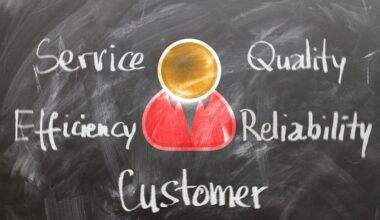Segmenting Customers for Targeted Loyalty Campaigns
In today’s competitive market, implementing effective loyalty programs relies heavily on accurately segmenting customers. This process involves categorizing customers based on behaviors, preferences, and spending patterns. By applying these segments, brands can create personalized loyalty campaigns that resonate with their target customers. Tailored communications often lead to higher engagement rates, increased customer satisfaction, and improved retention. Key segmentation criteria may include demographic factors such as age, gender, or income level. Additionally, psychographic factors, including lifestyle and values, can provide invaluable insights into customer motivations. This holistic approach ensures that the loyalty initiatives address specific customer needs and preferences based on the outlined segments. Furthermore, utilizing customer purchase history enhances this segmentation strategy. This data-driven approach allows marketers to identify which products resonate most with different segments, leading to more effective promotions. As digitization of marketing continues to evolve, leveraging analytics software becomes vital for identifying potential segments. Employing technological tools facilitates the collection and analysis of customer data, enriching marketers’ insights for impactful decision-making. Ultimately, understanding segments of loyalty-focused customers paves the way for innovative campaigns, fostering long-term relationships that benefit both brands and consumers.
Importance of Data-Driven Decision Making
Data-driven decision-making is essential for segmenting customers effectively in loyalty programs. It empowers marketers to utilize robust analytics, leading to strategic planning. This enables organizations to predict customer behavior patterns accurately and measure the success of their targeted campaigns. Relying on data rather than assumptions helps businesses tailor their offerings and promotions to match the precise needs of various segments. By deploying advanced analytics tools, companies can collect data from multiple sources, such as social media, purchase history, and customer feedback. This comprehensive data collection fosters a better understanding of the customer journey, ensuring that loyalty rewards align with customer preferences. A recent trend is the emphasis on real-time data analytics, allowing businesses to adapt their strategies swiftly. Monitoring customer responses in real-time enables immediate adjustments to ongoing campaigns, increasing their effectiveness. Moreover, segmentation based on data analysis can identify underperforming loyalty incentives, enabling organizations to refine their strategies effectively. Data-driven approaches also establish a solid foundation for measuring loyalty program performance, providing insights into customer retention rates and lifetime value. Effective segmentation driven by data is a game-changer for successful loyalty programs, enhancing customer engagement significantly.
Segmenting customers effectively involves utilizing various segmentation models, each offering unique advantages. These models enable brands to tailor their loyalty initiatives based on characteristics that resonate with the identified customer groups. For example, demographic segmentation separates customers by age, gender, income, or education level. In contrast, psychographic segmentation focuses on customers’ lifestyles, interests, and values. Behavioral segmentation considers customers’ interactions with a brand, emphasizing loyalty. There is also geographic segmentation, which categorizes customers based on their location, which can influence shopping habits. Implementing these diverse models creates dynamic and multifaceted loyalty programs. Furthermore, hybrid segmentation combines multiple factors for comprehensive insights, allowing businesses to engage different targeting strategies. Using a combination of segmentation methods can optimize customer outreach and enhance the customer experience. Personalized loyalty campaigns resonate more strongly with specific customer segments, increasing the likelihood of positive engagement. As businesses evolve, the adaptability of these segmentation strategies allows them to anticipate customer needs and preferences accurately. Lastly, the successful implementation of these segmented strategies relies on continuous analysis and adjustment, which helps brands maintain relevance in a rapidly shifting market.
Testing and Optimizing Loyalty Campaigns
Testing and optimizing loyalty campaigns is a vital step in maximizing segment effectiveness. It involves continuously evaluating and refining marketing strategies based on the unique characteristics of customer segments. By using A/B testing, marketers can determine which loyalty offers resonate best with specific groups. This data-driven method enables businesses to compare various strategies and choose the most effective one. Additionally, customer feedback plays a significant role in the optimization process. Gathering feedback through surveys can provide insights into customer preferences, enabling brands to adjust their programs accordingly. Monitoring key performance indicators, such as redemption rates or engagement levels, offers direct indications of campaign success. Monitoring metrics such as customer lifetime value and retention rates will help marketers assess the long-term impact of loyalty initiatives. Furthermore, creating customer personas based on segmentation data can enhance campaigns and refine targeted messaging. By understanding who their customers are, businesses can create more compelling narratives that resonate with each segment. Ultimately, the iterative nature of testing and optimization empowers brands to remain competitive, fostering lasting relationships with loyal customers while continually improving campaign effectiveness.
The successful management of segmented loyalty campaigns relies on integrating various communication channels. Multi-channel marketing enhances customer outreach and reinforces brand messaging. Customers respond to communication through email, social media, or mobile apps differently, depending on their segment. Understanding the preferred communication channels for each segment ensures the right messages reach customers effectively. Additionally, a personalized approach can elevate the customer experience through tailored content delivered across these channels. For example, sending exclusive rewards or personalized messages via email can enhance the loyalty experience significantly. By utilizing CRM systems and automation tools, businesses can streamline their communication efforts, ensuring timely and relevant outreach. Utilizing customer data analytics will help brands identify which channels yield the highest engagement for various segments. Moreover, businesses must remain agile and ready to adapt their multi-channel approaches based on real-time insights. A flexible channel strategy enables marketers to pivot quickly, ensuring their messages resonate correctly with evolving customer behaviors. This adaptability ensures that loyalty programs remain relevant and effective. Ultimately, an integrated communication strategy combined with segment-focused messaging will enhance customer loyalty and foster long-term brand engagement.
Engaging With Repeat Customers
Effectively engaging repeat customers is crucial for the success of loyalty programs. Repeat customers represent a significant portion of a brand’s revenue, making it essential to foster strong relationships with them. By segmenting these loyal patrons, businesses can devise personalized strategies that cater to their specific needs. Recognizing the unique preferences of repeat customers enables brands to offer tailored rewards, promotions, and experiences. For instance, rewarding frequent buyers with exclusive discounts or invites to VIP events fosters a sense of appreciation and value. Additionally, maintaining consistent communication with these loyal customers helps build a solid rapport over time. Engaging customers through personalized emails, updates about new products, or loyalty milestones ensures they feel valued. Integrating feedback mechanisms into loyalty programs can provide insights into customer satisfaction. By actively listening to repeat customers, brands can identify areas for improvement and refine their offerings. Utilizing targeted marketing campaigns, such as reminders for replenishing favorite products, cultivates ongoing engagement. This proactive approach reinforces loyalty and enhances the customer’s overall experience. Ultimately, engaging repeat customers effectively will encourage continued loyalty and advocacy, contributing positively to brand growth.
Lastly, evaluating the overall success of loyalty segmentation strategies is essential for sustainable improvement. Creating a feedback loop with relevant performance metrics allows brands to assess how well their campaigns resonate with targeted customer segments. Key performance indicators to track include engagement levels, redemption rates, and customer feedback ratings for ongoing campaigns. Conducting customer satisfaction surveys will also provide valuable insights; these surveys will help brands gain a deeper understanding of customer sentiments and satisfaction levels. Implementing these insights into future strategies fosters continuous improvement in loyalty programs. Regularly reviewing and analyzing performance reports empowers marketers to identify successful elements and areas needing enhancement. Furthermore, celebrating wins with both the marketing team and customers can build positive momentum. Communicating successful outcomes reinforces loyalty initiatives’ value while motivating teams to keep innovating. By recording lessons learned during the campaign lifecycle, brands can enhance future segmenting and campaign execution. In this fast-paced market, evaluating loyalty segmentation strategies will ensure that brands remain competitive and aligned with customer expectations. Ultimately, continuous assessment paves the way for long-term success in cultivating customer loyalty and strengthening brand relationships.
In conclusion, segmenting customers for targeted loyalty campaigns is essential for creating successful programs. Understanding the diverse needs and preferences of various customer groups enables brands to develop personalized strategies that resonate on a deeper level. By leveraging data-driven insights, brands can effectively tailor their messaging, rewards, and engagement tactics to meet customer expectations. Testing and optimization play critical roles in ensuring that loyalty campaigns remain effective and impactful, allowing brands to adapt to changing market dynamics and preferences. Continuous evaluation of customer segments is necessary to evolve strategies appropriately and foster deeper connections. Engaging with repeat customers through personalized communication strengthens their loyalty and encourages advocacy. Finally, implementing robust analytical processes enables brands to monitor performance, assess campaign success, and refine future strategies based on learnings. By prioritizing strategic segmentation, testing, and multi-channel engagement, businesses can successfully cultivate long-term relationships with customers. Ultimately, a strong commitment to segmenting and understanding the customer journey will support sustainable growth for businesses in a competitive marketplace. Creating tailored loyalty programs, rooted in segmented insights, embodies the future of customer engagement and relationship management.


